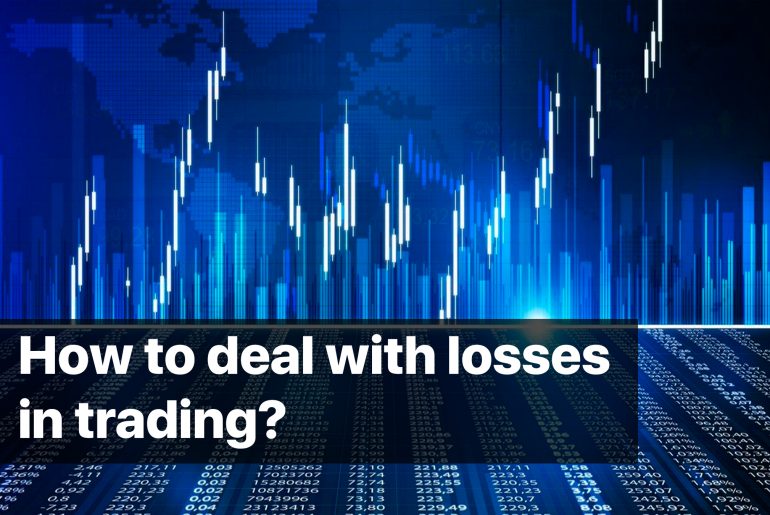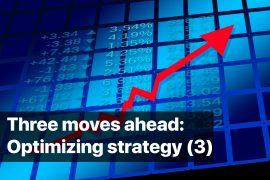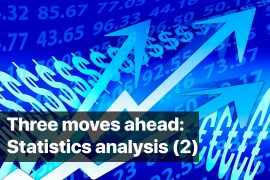Nobody likes to lose. It’s an undeniable fact that we should accept. Trading is related to wins and losses that we also cannot doubt about. Thus, having losses and feeling uncomfortable with them is common in trading, however, each perceives it in their own way. And this way of perception significantly influences the results of trading. Here a common mistake appears: The people are not accepting losses. Almost everyone feels more negative emotions having a loss of the amount A and less positive feelings with the same amount of profits (here we deal with humans’ psychology).
Let us look at how it works. Below you can see the charts with two assets you invested in a year ago. The first one (A) is bringing you profits, while the second one (B) – losses. And imagine you have a choice to close one of the trades to buy a new asset. What would you do?
You can sell asset A and get some profits, therefore, positive emotions (everybody likes to win and earn) What is more, you will avoid the risk of the price decrease (the position is closed, so, who cares). Even if the price continues to grow, the trade will be still profitable.
The other option is to close the position with asset B. This way, you will suffer losses and feel sad. Besides, if the price goes back to the level you bought the asset, you are likely to feel even more sad or silly (you missed an opportunity!). Thus, holding an asset B, you suffer losses and at the same time hope for the price coming back (keeping suffering losses).
Exactly this hope misleads you, often making the losses even bigger. The feelings you experience are related to the desire to achieve at least a breakeven. That is why you are expecting the price to go back, checking it anytime and hesitating to close the position, even being absolutely aware that your signal did not work. The case described makes a lot of traders wait (lose) a lot before finally selling the asset.
Keeping all this in mind, note that it is already proven that the losing trades usually remain this unlucky trend, while the winning ones are likely to continue bringing profits. Thus, in the long term, profitable trades closed too early and the losing ones opened for a long time may result in bankruptcy.
Get rid of losing trades!
Therefore, your strategy should include ways to control these losing positions, not letting your emotions take over. It means a trading system, structured trading rules, and risk management that will allow you to cut your losses. The absence of trading SYSTEM is one of the most common reasons 95% of traders lose and left trading.
Is stop-loss enough? (No)
Undeniably, it is difficult to quit the market with losses, but in many cases, it is the best option, as the losing trade can be compared with a torpedo, which can destroy your whole budget and profits brought by other trades. At first glance, the right solution to avoid such painful losses is a stop loss. So, you set it at a level that you can afford (for instance, 10% or 20% decrease), and the position is closed at the right moment. Nevertheless, this tool has some limitations.
It should be noted that the crypto market is incredibly volatile, and the price changes are also provoked by a variety of trading bots in the market. For instance, the prices of some crypto assets can drop during 5 minutes, and then return to the previous levels. Thus, these breakouts can make your stop loss work. As a result, you will lose and then see the price recovering in a couple of minutes.
That is why a single stop loss is not enough to deal with losses.
An effective trading system includes:
- Trading statistics gathering (manually/automatically) – to be aware of your wins & losses (here are some tips on how to analyze your stats!);
- Key trading performance metrics calculation – to assess your overall trading performance and reveal weaknesses (the reasons for losses);
- Trading limits to cut your losses. Thus, decide what part of the deposit you afford to lose (Maximum drawdown) and do not allow losing trades to exceed this level. Control this level and close the trades timely.
Tip: it is recommended to perform risk-management in trading via special software that gathers the stats without human mistakes, calculates the metrics, monitors them 24/7 and makes you aware if any of the limits are reached.
All these steps are recommended to any trader – newbie or professional. The way you perform them is up to you, but the result is the same: You cut losses and let the profit flow. You are aware of your trading performance, control and improve it. You do not depend on price spikes and your own emotions.
You cut losses and let the profit flow.
What is important to understand is that there is no trader who always has profits, but the most successful of them were doing their best to avoid mistakes and keep in control of their actions and emotions. Read how hedge funds control their losses and reach outstanding profitability in this article to apply these principles in your trading. It can help you stay in-game even in the case of 100 losses in a row! Wanna know how? Read here!
Interested in how to become one of the 5% of high achievers in trading? Then this article is for you!
Stay tuned and join our social media:
Telegram: https://t.me/bitinsurecom
Facebook: https://www.facebook.com/bitinsure
Twitter: https://twitter.com/bitinsure_news





